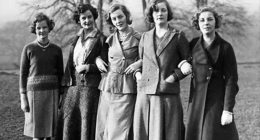
London’s golf courses make up an area larger than the borough of Brent and there is enough space on publicly owned courses to house 300,000 people, according to new research.
Nearly half of the capital’s 94 active golf courses are owned by London boroughs or other public bodies, such as the Church Commissioners, and yet serve a tiny fraction of the capital’s 9 million residents.
Russell Curtis, an architect and the author of “Golf Belt”, a new study of how London’s golf courses could help address the housing crisis, said he was not calling for all the capital’s golf courses to be turned into housing but that some courses could be made more accessible to the capital’s residents if they became allotments, biodiverse green space, sports facilities or even urban farms.
“This is not a war on golf,” said Curtis. “There surely has to be a way of improving the social utility and accessibility of golf courses to benefit the wider population. The redevelopment of golf courses is always presented as a binary choice between beautiful green fields or concrete, but there’s a model in the middle where you could provide new homes and social infrastructure while achieving biodiversity gain.”
According to the study, Britain is home to a quarter of all the golf courses in Europe, with one in 20 found in London, despite the capital making up just 0.65% of the UK’s total land area.
The 43 publicly owned golf courses in London take up just under 1,600 hectares (3,950 acres) of land in Greater London, bigger than the borough of Hammersmith & Fulham, which has a population of 185,000.
The borough of Enfield alone contains seven courses, but the council receives just £13,500 from Enfield golf club each year to rent its 39-hectare golf course – less than the typical annual rent for a two-bedroom flat in the area.
Enfield council is currently consulting over a controversial local plan which includes the release of green belt for 6,000 homes, including at least 3,000 houses around Crews Hill railway station, which currently contains open fields, garden centres – and a golf course.
Building at a density of 60 homes per hectare on publicly owned golf courses that fall within areas designated as suitable for further development by the London Mayor’s local plan – close to railway stations, for instance – would provide homes for 101,700 people – more than half the 178,000 people living in temporary accommodation in London. According to Curtis, the area currently occupied by a single golfer could provide homes for about 380 people.
The campaigner Guy Shrubsole launched a petition to open urban golf courses to the public for exercise during the first lockdown, a move made by some local authorities such as Brighton & Hove city council, which allowed the general public on to the course at Hollingbury. In 2019, Lewisham council turned a golf course into Beckenham Place Park, a new public space for Londoners with a swimming lake, wildlife habitats and a 5km-long running and cycle track.
Shrubsole, the author of Who Owns England?, said: “Lockdown starkly demonstrated how unequal access to green space is in our cities. With so much of London devoted to golf courses only used by a small segment of society, surely councils should be repurposing more of them as public parks and nature reserves, with open access for all.”
The ability of parks to serve more people than golf courses is starkly illustrated by the Golf Belt study, which calculated that an 18-hole course can only accommodate 72 players at any one time, allowing a maximum of 216 players a course on a typical summer’s day.
If the 166 hectares of Regent’s Park were to become a golf course, it could only be used by 314 people in a day; the park received more than 26,000 visitors each day in 2007.
According to England Golf, the governing body for amateur golf, 40,000 members play at the 94 London clubs and up to 160,000 additional people use the courses on a pay-as-you-play basis.
Matthew Draper, the club, county and membership senior manager at England Golf, said: “Golf positively contributes to the financial, environmental and social wellbeing of the communities in which it is played.
“The sport provides people with a myriad of physical and mental health benefits, with courses allowing access to open green spaces, time away from the day-to-day stresses of work and life, a social community and a gentle source of exercise that is enjoyed by over 3 million people, of all ages and ability, on a monthly basis.
“Analysis shows that a high percentage of golfers are reliant on the sport for their physical activity in comparison to other sports, especially in densely populated areas.
“Furthermore, golf courses provide a natural habitat to wildlife and plant life and, with governing bodies recognising and emphasising the importance of sustainability, have a role to play in positively impacting the environment and the communities in which they sit.”
Although councils such as Enfield are seeking to release green belt land for housing, planning regulations protect most of London’s golf courses from being built on because they are either green belt or designated as “metropolitan open land”, a form of protection unique to the capital.
Sadiq Khan, the London mayor, has signalled his determination to protect the green belt, but Curtis, who is one of 50 design advocates appointed by the mayor to support truly sustainable development, questioned whether golf courses meet the definition of metropolitan open land.
The criteria for metropolitan open land includes providing open air facilities that “serve either the whole or significant parts of London”, containing features of national or city-wide value and forming part of a strategic corridor of green infrastructure. The only criterion unequivocally met by golf courses is that they are distinguishable from the surrounding built-up area.
Curtis said that changing the use of some golf courses and consolidating some golf clubs could help struggling clubs and enable them to build better facilities for their communities.
“I’m hoping a discussion might come out of it that involves the clubs as well,” he said. “It’s quite difficult and emotive because it’s not just about planning but about ownership and – let’s be honest – about class too. This land could be thought about in a more creative way.”
Source: Guardian








